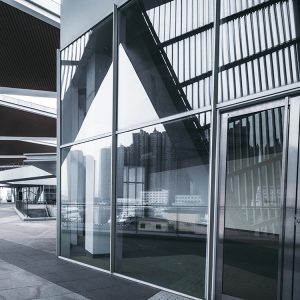Curtain Wall Efficiency in Modern Architecture
Modern Curtain Wall Design Features
When it comes to modern curtain wall design, glazing and insulation can help limit the ease in which heat flows into and out of a building. These years, “Low-E” glass, low emissivity, is a glazing that takes advantage of the Sun’s visible light while limiting the amount of heat that typically travels with it, especially in the summer. Creating the glazing is achieved by coating the glass with a variety of metals and chemicals including silver and silicon. This coating gives the glass the ability to deflect the infrared quality of light which carries heat. Another way you limit heat transfer in curtain walls is with insulation. Systems can be installed between the connections of each glass panel. Focusing on the connections can eliminate any possibility for air leakage as well.

In recent years, structural glass curtain walls are a very aesthetically pleasing feature for large commercial buildings. They allow buildings to take advantage of natural daylighting. They make buildings appear “light” without having the typical enclosures of concrete or heavy walls. And they also give the building a sense of transparency for visitors viewing the building from afar. With all of the benefits of extensive glass, curtain walls can negatively affect a building’s energy efficiently if not installed carefully. Furthermore, curtain walls essentially serve as floor to ceiling windows, so while allowing daylight in heat can also enter and leave the building quite freely due to its “potential for large heat gains and losses.” In the winter, the large amount of glass can potentially hurt you heating bill by letting heat out; and in the summer, energy costs can rise due to the heat of the daylight entering causing occupants to want air conditioning.
Active/ Passive Curtain Wall System
Active / Passive curtain wall are used in many commercial buildings, which is a non-load bearing light weight structure usually attached to the outside of a building. Both of two types of curtain wall systems are generally used as a protective layer against rain and wind whilst allowing maximum sunlight to penetrate through.
1. Active Curtain Wall System
The active curtain wall systems incorporates a flap which switches on and off to circulate hot air back out to the exterior in the summer and keep hot in inside the building during the winter season. This mechanical flap is powered by a PV Cell attached the curtain wall. As with all mechanical systems, this requires energy and a lot of maintenance to keep all moving parts running.
2. Passive Curtain Wall System
The idea of controlling the exchange of passive airflow for different seasons can actually improve interior environment. This omits the user input as the building responds naturally to the changing environment. In comparison, the active system will not be widely used because of high fixed curtain wall costs and even higher maintenance costs. Sometimes, changing to materials that respond to the weather naturally may reduce mechanical parts.
Tel: +86 18202256900 Email: steel@tjdpbd.com









